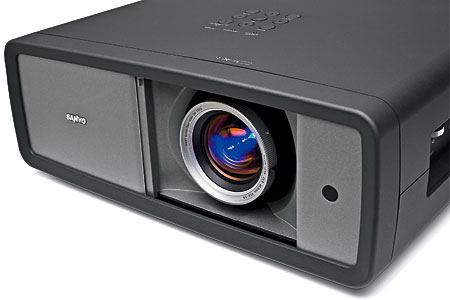Sanyo PLV-Z3000 LCD Projector Page 2
Screening
The Sanyo’s video processing was equal to or better than what I’ve seen in many projectors that cost much more. In 480i-to-1080p operation, it produced visible artifacts only on our 2:2 (video-based) tests. It was excellent across the board when deinterlacing 1080i sources to 1080p.

With Overscan off, the Sanyo produced a perfect 1:1 pixel map. It reproduces above white and below black, but only when the HDMI setup control is on Enhanced.
Some of the PLV-Z3000’s nifty features were less useful than I expected. I found neither 5:5 pulldown nor Smooth Motion to be particularly effective. I didn’t use them except to check their operation. Smooth Motion reduced motion lag a little, and as is typical of motion interpolation, it made film-based sources look a bit like video. But both of these effects were relatively easy to spot only in the High setting.
 As you’ll see in the measurements sections, the Sanyo’s post-calibration color tracking (gray scale) is good, but its color gamut is too wide and uncorrectable. The Color Management controls did not have enough range to pull in the PLV-Z3000’s overextended color points and still maintain the required color intensity. After several fruitless attempts to get things right, I decided that the stock color gamut was preferable, and I left the Color Management off. In Sanyo’s defense, it’s not alone in this. The consumer video world is now full of color management systems that are obviously intended to let the consumer simply play with the colors. They don’t provide enough control to let a calibrator get the colors right.
As you’ll see in the measurements sections, the Sanyo’s post-calibration color tracking (gray scale) is good, but its color gamut is too wide and uncorrectable. The Color Management controls did not have enough range to pull in the PLV-Z3000’s overextended color points and still maintain the required color intensity. After several fruitless attempts to get things right, I decided that the stock color gamut was preferable, and I left the Color Management off. In Sanyo’s defense, it’s not alone in this. The consumer video world is now full of color management systems that are obviously intended to let the consumer simply play with the colors. They don’t provide enough control to let a calibrator get the colors right.
The multicolored outdoor landscapes of the alien world in Pitch Black were as eerie as the director likely intended—perhaps even a bit more so. Naturally lit interior shots (rare in this film) were a bit too saturated, with fleshtones shifted toward orange. The same was also true of many (but not all) scenes in other films.
But the Sanyo’s colors were not unpleasant. Modern films often use an aggressively creative color palette, so the only way to subjectively judge color is with program sources that are clearly unprocessed. A good reference for this is the making-of features on the Indiana Jones and the Kingdom of the Crystal Skull two-disc Blu-ray set. On this test, the Sanyo’s fleshtones were good. Green foliage here and elsewhere could still be too potent, but not distractingly so. While the Sanyo’s colors are definitely not as technically accurate as the purist in me would like, I doubt if many viewers will object to its rich, deep, but not distractingly wrong or over-the-top palette.
I had no complaints with the PLV-Z3000’s resolution. While it isn’t the most crisply detailed projector I’ve ever tested, in no way would I call its image soft on my 78-inch-wide screen. Baraka is one of the most stunningly detailed Blu-ray Discs I’ve seen. The fact that it was shot in 70mm certainly helps, and it also helps that the images are either so slow that they have the resolution of a still, or so maniacally fast that the resulting motion smear is deliberate. It looked terrific on the Sanyo, arguably crisper than on my reference projector for the past two years, the JVC DLA-RS1. Even when I blew up the image on my pseudo larger screen (as described in this report’s opening remarks), the detail held up impressively, and the brightness remained more than adequate.
With its auto iris engaged, the Sanyo’s black level and shadow detail were solid, if not quite state of the art. Only rarely did I see any sign of the light-gray fog that can accompany less-than-pristine blacks. And even then it only showed in the lowest-contrast scenes with no bright highlights. Pitch Black never disappointed, and my favorite dark-scene references from Stargate: Continuum and Master and Commander: The Far Side of the World were handled well.
I also directly compared the Sanyo with the JVC. For more detail on this, see the JVC report. I will say here that, apart from brightness, the two were a lot closer than the $1,200 difference in price might suggest.
Conclusions
Despite a color gamut that should be more accurate and a color
management system unable to correct for this, the Sanyo produced a very impressive picture. Two years ago, you wouldn’t get this sort of performance for even twice the price. If you can accommodate the need for a separate screen and a darkened room, you might consider a projection setup as an alternative to a one-piece, flat-panel television monitor for your home theater. Now this is possible even on a beer (or at least high-end beer) budget.

- Log in or register to post comments





























































